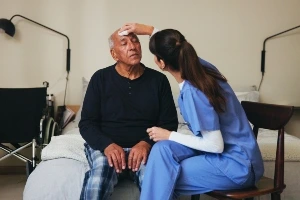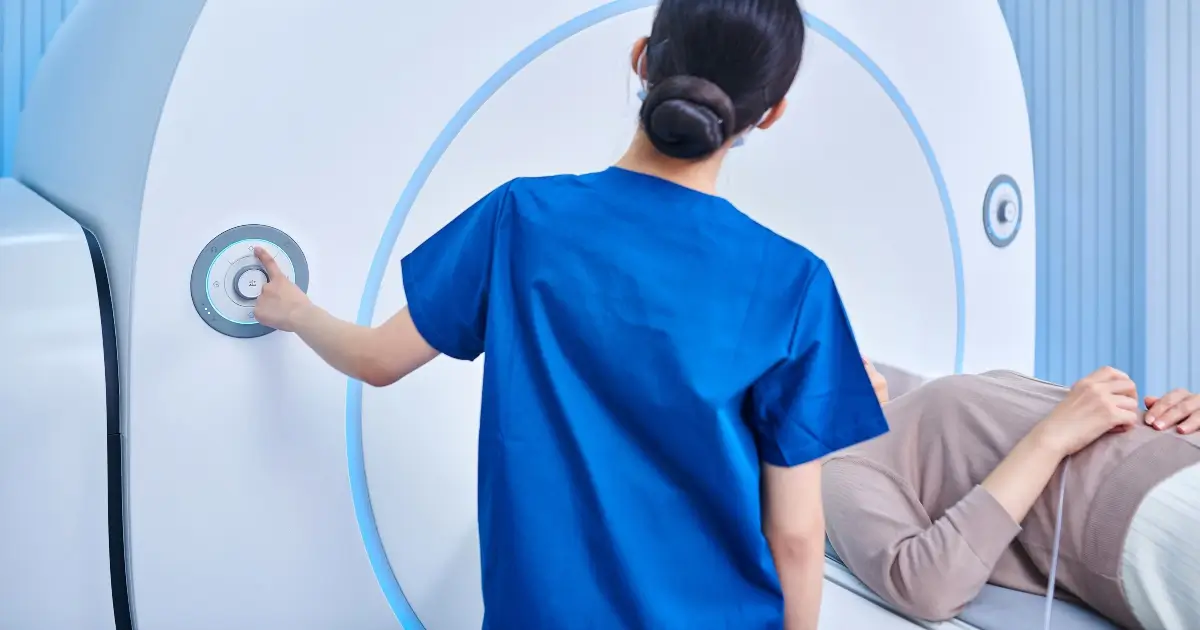
Nursing home residents are always at risk of suffering a head injury. Whether it is the result of slipping on the floor when walking unattended or falling out of an unsecured bed, a head injury for an elderly resident could quickly lead to serious complications without immediate medical help.
At PKSD, our knowledgeable Albuquerque nursing home abuse attorneys are here to answer your questions and discuss your concerns after your loved one sustained a head injury in a long-term care facility. Your initial consultation is completely free, so there is no risk in calling to learn more about your legal options. We are here to help you.
Schedule your free case review today: 505-677-7777
What Is a Nursing Home’s Responsibility After a Resident Falls in Albuquerque?
When a resident falls in an Albuquerque nursing home, the facility has several immediate and follow-up responsibilities to ensure proper care and prevent future incidents. Staff must follow specific protocols based on the resident’s care plan, medical conditions, and medications.
Immediate Medical Response
The nursing home must provide prompt medical attention following any fall. Staff should thoroughly assess residents for injuries and document the incident to ensure accurate and complete records. They must arrange immediate transport to a hospital or emergency care facility if serious injuries appear. New Mexico laws require nursing homes to have emergency protocols for fall incidents.
Notification Requirements
After a fall occurs, Albuquerque nursing homes must notify:
- The resident’s physician
- The resident’s family or legal representative
- The New Mexico Department of Health (for severe injuries)
This notification should happen promptly, typically within 24 hours of the incident.
Documentation and Investigation
The facility must thoroughly document the fall, including:
- Staff present
- Injuries sustained
- Medical care provided
- Date, time, and location of the fall
- Circumstances surrounding the incident
Additionally, the nursing home must conduct a thorough investigation to determine the cause of the fall and identify preventive measures for the future.
Care Plan Updates
After a fall, the nursing home must reassess the resident’s fall risk and update their care plan accordingly. This may include implementing new safety measures such as bed alarms, frequent monitoring, physical therapy, or mobility assistance.
Prevention Measures
Albuquerque nursing homes must take steps to prevent future falls, which may include:
- Training staff on fall prevention
- Providing appropriate mobility aids
- Conducting environmental assessments to identify hazards
- Reviewing medication regimens that might contribute to fall risk
Why Are Head Injuries of Nursing Home Residents So Dangerous?
Nursing home residents’ head injuries could lead to severe risks that could make it difficult for them to recover.
Age-Related Physiological Vulnerabilities
Nursing home residents typically have physiological changes that amplify the dangers of head trauma. These changes may include:
- Thinner Blood Vessels: Aging causes blood vessels to become more fragile and prone to tearing, increasing the risk of brain hemorrhages even from seemingly minor impacts.
- Brain Atrophy: Our brains naturally shrink as we age, creating more space between the brain and skull. This allows greater movement during impact, potentially causing blood vessels and nerve fibers to tear.
- Reduced Healing Capacity: Elderly individuals’ brains heal more slowly and less completely after an injury because their cells regenerate at a reduced rate.
Medication Complications
Many nursing home residents take medications that significantly increase head injury risks:
- Blood Thinners: Commonly prescribed anticoagulants like warfarin or newer medications like apixaban can transform a minor head injury into a life-threatening brain bleed.
- Sedatives and Psychotropics: These medications can mask symptoms of head injuries, potentially delaying critical treatment and assessment.
- Anticonvulsants: This medication prevents seizures after an injury but can also sedate or slow down cognitive functions.
- Antidepressants: This type of medication affects mood, cognition, and bleeding risk.
Comorbid Conditions
Existing health conditions common among nursing home residents compound head injury dangers:
- Osteoporosis: This condition weakens bones, providing less protection during a fall and potentially allowing greater force transfer to the brain.
- Diabetes and Hypertension: These conditions already compromise blood vessel integrity and can worsen bleeding and swelling after head trauma.
- Dementia: Residents with cognitive impairments may be unable to accurately report symptoms, leading to delayed diagnosis of severe head injuries.
Symptom Recognition Challenges
Detecting head injuries in nursing home residents presents unique difficulties:
- Altered Presentation: Elderly individuals often do not display typical head injury symptoms, making recognition difficult even for experienced staff.
- Communication Barriers: Residents with speech or cognitive impairments may struggle to describe symptoms or changes in their condition.
- Symptom Attribution Errors: Staff may mistakenly attribute confusion, drowsiness, or behavioral changes to existing conditions rather than recognizing them as potential head injury symptoms.
How Do Head Injuries Go Unnoticed in Albuquerque Nursing Homes
Despite the serious nature of head injuries, they frequently go undetected in Albuquerque nursing homes due to a complex interplay of factors specific to elder care environments. Families that understand these challenges can recognize them and take action to stop or prevent further injuries.
Subtle or atypical symptoms may manifest differently depending on each resident’s health condition or medication regimen. The key subtle signs you should look for are:
- Mild confusion or slight personality shifts
- Gradual signs of injuries over hours or days can make a connection to a specific incident less obvious
- Pre-existing conditions like dementia can mask cognitive symptoms typically associated with head trauma
Head injuries can also go undetected for the following reasons:
- Staffing and Training Limitations: Structural issues within Albuquerque’s nursing home system, including high staff turnover and high staff-to-resident ratios, contribute to missed head injuries.
- Documentation and Communication Breakdowns: Systemic communication issues, particularly during shift changes or unreported incidents, frequently result in missed head injuries.
- Fragmented Medical Records: When multiple providers are involved, limited access to detailed health records can make it more difficult to detect subtle changes.
Can I Sue a Nursing Home for Damages if My Loved One Suffered a Head Injury?
Yes, you could sue a nursing home for damages if your loved one suffered a head injury due to negligence, abuse, or substandard care. Nursing homes are legally obligated to provide safe environments and proper care for their residents. When they fail to meet these responsibilities and a resident sustains a head injury as a result, the facility can be held liable for damages, including medical expenses, pain and suffering, and wrongful death if applicable.
The most common basis for nursing home head injury lawsuits is negligence. You must demonstrate that the nursing staff breached their duty of care and directly caused your loved one’s head injury to prove negligence. This breach might include inadequate supervision, failure to implement fall prevention measures, improper medication management, or insufficient staffing levels that led to unsafe conditions.
When May a Nursing Home Be Liable for a Resident’s Head Injury in New Mexico?
A New Mexico nursing home may be liable for a head injury if it breaks safety rules, violates care standards, or creates dangerous conditions. New Mexico law requires nursing homes to meet specific care standards and allows families to seek compensation for preventable head injuries when those duties are violated.
Duty of Reasonable Care
Under New Mexico law, nursing homes owe residents a duty of reasonable care based on professional standards and each resident’s specific needs. This duty requires facilities to assess residents’ fall risks, implement appropriate safety measures, and continuously monitor changing conditions that might increase injury risks. When head injuries occur due to failure to meet this standard, facilities can be liable.
Compliance with State Regulations
New Mexico’s Department of Health regulates nursing homes through detailed administrative rules establishing minimum care standards. These regulations cover staffing requirements, safety protocols, medication management, and incident reporting procedures. Violations of these state regulations contributing to head injuries can be evidence of negligence in liability claims.
Federal Standards Integration
New Mexico nursing homes must comply with federal Centers for Medicare & Medicaid Services (CMS) regulations. These federal standards are integrated into state oversight and create additional liability exposure when violations contribute to resident injuries. Federal survey findings and deficiency citations often provide crucial evidence in head injury cases.
What Compensation Can I Recover for a Nursing Home Head Injury in New Mexico?
In New Mexico, you can seek compensation for nursing home head injuries, including medical costs, pain, lost quality of life, and possibly punitive damages. New Mexico law provides broad recovery options for nursing home injury victims without caps on most damage categories. This allows courts to award compensation that reflects the full impact of preventable head injuries.
Medical Expenses and Healthcare Costs
These may include emergency medical expenses related to the head injury, ongoing medical treatment, and future medical costs. After a head injury, specialized equipment like wheelchairs and bathroom modifications may be needed.
Pain and Suffering Damages
Residents and their families may receive compensation for physical pain, emotional distress, and mental anguish, and loss of enjoyment of life. New Mexico law recognizes that head injuries cause significant physical pain that deserves compensation beyond medical expenses and covers emotional harm.
This includes compensation for headaches, neurological pain, discomfort from medical procedures, and ongoing physical suffering related to the injury and its treatment.
Family Member Expenses
New Mexico law allows families to recover costs related to caring for a loved one with a head injury, like travel, lost wages, and other out-of-pocket expenses.
Wrongful Death Damages
If a nursing home resident’s head injury results in death, surviving family members can pursue wrongful death claims. These claims provide additional compensation categories beyond what would be available for non-fatal injuries, such as funeral, burial expenses, loss of companionship and support.
Tactics Nursing Homes May Use to Avoid Liability for a Head Injury in Albuquerque
Nursing homes in Albuquerque may implement sophisticated legal and business strategies designed to minimize or eliminate their liability when residents suffer head injuries. These tactics range from contractual maneuvers during admission to aggressive legal defenses during litigation.
Mandatory Arbitration Clauses
Many Albuquerque nursing homes include arbitration agreements in admission contracts, forcing families to settle disputes privately instead of in court. These agreements often benefit the facility by limiting evidence sharing, removing the right to a jury trial, and using arbitrators tied to the nursing home industry.
Liability Waivers and Releases
Nursing homes often include broad liability waivers in admission agreements to avoid responsibility for injuries like head injuries from falls. Although New Mexico law limits how enforceable these waivers are in facilities, they still use them to discourage lawsuits or make legal claims harder.
Corporate Structure Manipulation
Albuquerque nursing homes often operate under complex corporate structures with multiple limited liability entities. The facility may be owned by one corporation, managed by another, and staffed through a third entity. This structure is designed to limit the assets available to satisfy judgments and make it challenging to identify the responsible parties.
Insurance Coverage Limitations
Some nursing homes structure their insurance to reduce payouts, using high deductibles, limited coverage, or self-insurance. They may also shift assets to other companies to avoid financial responsibility for injuries.
How to Tell if Your Loved One’s Head Injury Was Preventable
You can verify certain factors to determine whether your loved one’s nursing home head injury was preventable. Examine the circumstances leading to the incident, evaluate the facility’s safety protocols, and assess whether proper care standards are followed. Most head injuries in nursing homes are preventable when facilities implement appropriate safety measures, maintain adequate staffing, and follow established care protocols designed to protect vulnerable residents.
Warning signs of preventable head injuries:
- Inadequate Fall Risk Assessment: Preventable head injuries often occur when nursing homes fail to properly assess residents’ fall risks or don’t update these assessments when conditions change.
- Missing or Ignored Safety Measures: Some fall injuries involve high-risk residents who lack bed alarms, reachable call buttons, proper footwear, or help with transfers. These injuries are preventable if basic safety equipment is available but not used.
- Staffing Issues During the Incident: Head injuries that occur when residents are left unattended despite needing supervision suggest preventable incidents.
- Environmental Hazards: Injuries from obvious environmental dangers, such as wet floors, broken equipment, or inadequate lighting, indicate preventable incidents.
Evidence to Establish Nursing Home Negligence Led to Your Loved One’s Head Injury
You must show that the facility failed to meet accepted care standards and caused your loved one’s injury. You must gather records and expert opinions that prove the facility acted carelessly and caused preventable harm to build a strong case.
Evidence you may use in your case:
Medical Documentation and Records
- Medication Records: Medication logs can reveal improper management contributing to head injuries.
- Care Plans and Physician Orders: Written care plans establish the standard of care your loved one should have received.
- Emergency and Hospital Records: Emergency department records provide baseline evidence of head injury, including initial assessment, diagnostic imaging, and physician observations.
- Nursing Home Medical Charts: Medical Charts document your loved one’s condition before and after injury, revealing whether the facility properly assessed fall risks and implemented safety measures.
Incident and Witness Evidence
- Incident Reports: Internal reports often contain admissions of staff errors, policy violations, or environmental hazards.
- Staff Witness Statements: Employees who witnessed the incident can provide crucial evidence about negligent practices.
- Security Camera Footage: Video surveillance provides objective evidence about circumstances leading to head injuries.
Staffing and Training Evidence
- Staffing Documentation: Records of low staffing during the injury support negligence, especially if residents needing supervision were left alone.
- Training Records: Staff training documentation, qualifications, and background checks reveal whether facilities employed adequately trained personnel.
- High Turnover Evidence: Frequent staff changes suggest ongoing issues that lead to negligent care and higher risks of injury.
Environmental and Safety Evidence
- Inspection Reports: State and federal inspection reports reveal safety violations, maintenance failures, or environmental hazards contributing to head injuries.
- Maintenance Records: Documentation of equipment failures, delayed repairs, or inadequate maintenance establishes negligence when these issues contribute to injuries.
- Environmental Hazards: Photographs of hazardous conditions, such as wet floors, poor lighting, or broken furniture, establish premises liability.
Contact Our Albuquerque Law Firm for Help After a Nursing Home Head Injury
Head injuries in nursing homes represent a serious threat to resident safety and well-being. The consequences can be devastating, especially for elderly residents who may already have pre-existing medical conditions.
At PKSD, we have a proven track record of fighting for the rights of nursing home residents who have suffered preventable injuries due to substandard care. When nursing home negligence or abuse leads to a head injury, residents and their families deserve justice. Although compensation cannot undo what happened, our knowledgeable attorneys will help you and your family navigate the legal process.
Learn more about your legal options: 505-677-7777.






